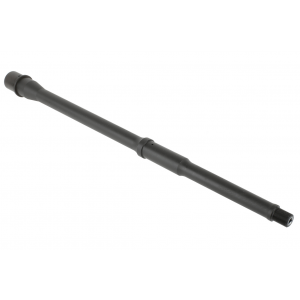Building a rifle involves crucial decisions, each with its significance. Every part represents a compromise, prioritizing one aspect over another. The barrel’s length is a key factor, carrying both literal and metaphorical weight. It significantly influences a rifle’s performance and suitability for its intended tasks. Choosing the right barrel length means balancing velocity and weight. In the following sections, we’ll discuss how barrel length affects AR-15 performance, strategies for selection, and popular AR-15 barrel options.
UNDERSTANDING AR-15 BARREL LENGTHS
The main consideration for barrel length involves balancing weight and velocity. Longer barrels generally offer higher velocity but also increase weight. Accuracy is nuanced; longer barrels don’t always mean better accuracy. Factors like rifling quality and barrel design affect mechanical accuracy. Practical accuracy can be influenced by velocity, especially at unknown distances. Higher muzzle velocities lead to flatter trajectories, aiding accuracy. Barrel length also affects rifle maneuverability, crucial for applications like home defense.
FACTORS TO CONSIDER WHEN CHOOSING THE BEST BARREL LENGTH
When determining the ideal barrel length for your AR-15, consider its intended use foremost. Effective range, distinct from maximum range, should guide your decision-making process. Maximum range denotes the farthest distance at which hitting a target remains feasible, whereas effective range encompasses the distance ensuring sufficient terminal effect upon impact.
Terminal effect requirements vary based on the target; for instance, hunting rifles necessitate delivering adequate kinetic energy for ethical kills. Thus, effective range considerations should align with the desired terminal performance.
To determine an appropriate barrel length, identify the required effective range and ascertain the necessary muzzle velocity to achieve satisfactory terminal performance with your chosen cartridge. This enables the elimination of barrels unable to attain the requisite velocity.
Additionally, mobility and maneuverability considerations are pertinent, particularly for applications like home defense. While longer barrels facilitate longer-range engagements, they may prove unwieldy in close-quarters situations. However, barrels shorter than 16 inches may trigger regulatory requirements under the National Firearms Act (NFA), necessitating additional paperwork and compliance measures.
POPULAR AR-15 BARREL LENGTHS
Although various barrel lengths exist for AR-15 rifles, certain lengths enjoy widespread popularity due to their balanced characteristics. Notably, the following lengths are well-regarded for their versatility and performance across different applications.
- ALL-PURPOSE BARRELS: 16-INCH & 14.5-INCH
- The 16-inch barrel stands out as the most prevalent choice for AR-15 rifles, offering a commendable balance between ballistics and maneuverability. Its popularity stems from being the minimum allowable length without NFA restrictions. Similarly, 14.5-inch barrels offer comparable performance, albeit requiring a pinned and welded muzzle device to meet length requirements.
- HOME DEFENSE/ SHORT RANGE BARRELS: 11.5-INCH & 10.5-INCH
- For close-quarters engagements, shorter barrel lengths like 11.5 inches and 10.5 inches are popular choices. While 10.5-inch barrels prioritize compactness, 11.5-inch barrels offer slightly enhanced velocity and effective range, making them versatile options for short-range applications.
- LONG RANGE BARREL: 20-INCH
- Long-range rifles typically feature longer barrels for enhanced velocity. The 20-inch barrel strikes a balance between velocity and maneuverability, offering substantial performance without excessive length. Despite its suitability for long-range shooting, it remains manageable for medium-range engagements.
CONCLUSION
In conclusion, barrel length significantly impacts a rifle’s performance, influencing factors such as range, mobility, and maneuverability. When selecting a barrel length, consider your intended application, desired effective range, and regulatory constraints. By aligning these factors, you can choose a barrel length that optimizes your rifle’s performance for its intended purpose.

